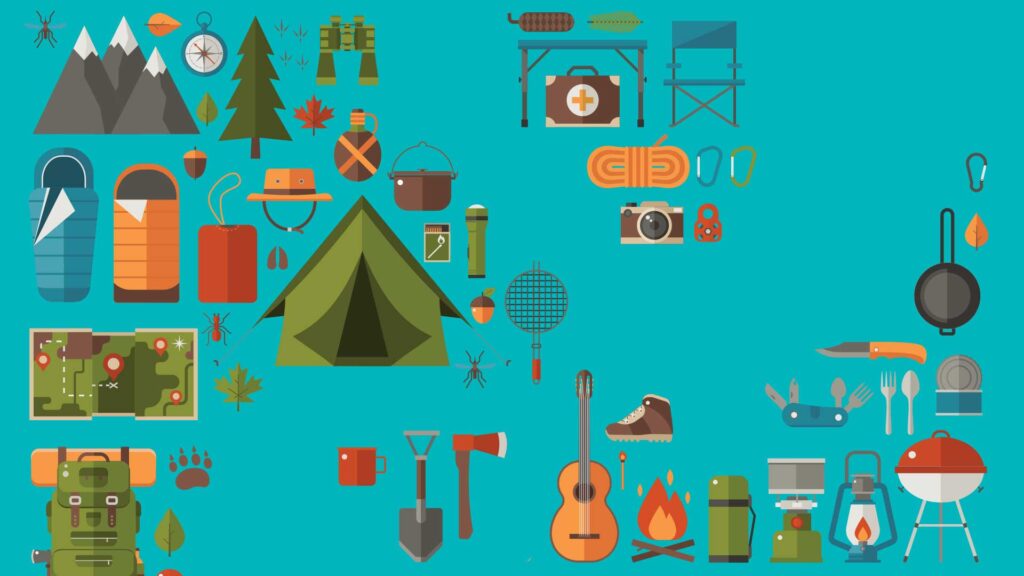No outdoor activity is more suited to summertime than camping. Warm days and comfortable nights make a tent the perfect home away from home for your family, especially in the Black Hills, where campsites are rarely inundated with crowds and adventure is always near at hand. Whether you’re planning on hiking, fishing, swimming, boating, or simply sitting around a fire telling ghost stories and eating s’mores, camping is an ideal way to get the most out of our gorgeous but fleeting summer weather.
If you’ve never pitched a tent or built a fire before, or are bringing along your kids for the first time, a camping trip might seem intimidating. But with a little advance preparation, you’ll be ready for whatever Mother Nature dishes out.
And by the summer’s end, you’ll be a camping pro!
As with any activity, camping requires certain gear. Fortunately, after your initial investment, there is very little you’ll need to purchase in the future, other than food (and the cost of your campsite).
TENT
Once you’ve been camping for a while, you might want to purchase a camper or RV, but most people keep it simple at first and start out with a tent. You’ll want to make sure camping is something the entire family enjoys (and does often enough) before splurging on something fancier. Tents come in a wide variety of shapes, styles, and sizes; we’re assuming you are a newbie and will be sticking to weekend getaways in the summertime…at least for now. A double-walled “three-season” tent will provide you with a floor, mesh walls, excellent ventilation, and a waterproof rain fly — always a good idea in the Black Hills, where summer thunderstorms are common. Your most important consideration will be the number of people in your family. Sleeping capacity ranges from one to as many as eight people; it’s best to err on the side of caution and choose a tent that is a little larger than you think you need, since you’ll be storing bags and backpacks in there, as well. If your kids are older, consider separate tents for privacy.
SLEEPING BAGS
As with tents, there are a lot of choices when it comes to sleeping bags, too. They are available in different weights suited to a wide range of temperatures. A good rule of thumb is to choose a sleeping bag with a temperature rating a little lower than the average overnight low you’re expecting (even during midsummer, lows in the Black Hills can drop into the 30s, so keep that in mind). Another important consideration is insulation materials. Sleeping bags are made with either down or synthetic filling; each has pros and cons. Down is lightweight, durable, and excellent in cold, dry climates, while synthetic provides insulation against moisture, dries quickly, and is non-allergenic. Decide which is best based on your own needs.
LANTERN OR FLASHLIGHT
When you’re far from the nearest metropolis, it gets very dark once the sun goes down. You’ll need dependable sources of lighting so you can see, both inside your tent and around your picnic table. Portable, battery-powered lanterns are cheap and useful, as are flashlights…especially if you need to answer nature’s call in the middle of the night!
COOLER
You’ll need a cooler or ice chest to keep your food cold and prevent it from spoiling. Whether you prefer a soft or hard cooler is a matter of personal opinion; both work fine, but there are trade-offs: soft coolers are easily portable and less expensive, but hard coolers offer better insulation.
HIKING SHOES
As fashionable as you may want to be, you will want to make sure you and your family have the proper foot attire when heading out to the trails and camping. Avoid walking around barefoot! Between broken glass, pokey stickers, and rocks–it’s best to keep your feet covered. Closed-toe shoes are often best.
CAMPING STOVE
While not strictly a necessity (most campsites include fire pits or grills), a camping stove is a good idea in case you have trouble building a fire or an unexpected rainfall renders your firewood or charcoal unusable. Portable two-burner camping stoves that use liquid fuel are dependable and easy to use.
MATCHES
There are a lot of alternatives to lighting a fire, but matches can be a great staple to keep with your camping gear. Not only do they last a long time, they are inexpensive, lightweight, and simple to store just about anywhere.
CAMERA
Arguably the best part of camping as a family is the memories you make together. Have your camera at the ready to capture the fishing trips, the campsite, the fun at the swimming hole, and the stories around the campfire.
If you’re using your cell phone to capture these images, be sure to save the best of the best rather than hundreds of photos. This way, you’ll be more apt to look back on them at a later date. Better yet? Print them out! There are numerous online uploads that will have your images ready in moments.
CHAIRS
Many campsites have picnic tables, but these can become dirty or wet, and aren’t exactly conducive to sitting around the fire. Portable, folding camp chairs are available in a wide range of styles; some even come with cup holders and adjustable head and foot rests. Your main requirement should be comfort, so be sure to try out a few different ones before purchasing.

